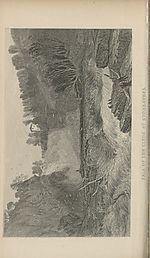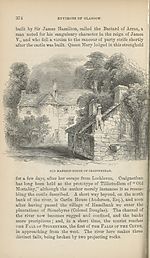Download files
Complete book:
Individual page:
Thumbnail gallery: Grid view | List view

373
LANARK AND THE FALLS OF THE CLYDE.
From Hamilton the tourist may reach Lanark by proceed¬
ing to Motherwell Station of the Caledonian Railway, two
miles distant, and there taking the train ; or he may pursue
the road up the river side. If he take the road, he crosses the
Avon half a mile from Hamilton. About a mile and a half
beyond this, the road strikes off the Carlisle highway, and gra¬
dually descends towards the margin of the river. On the
opposite bank of the Clyde is Dalziel House (Hamilton, Esq.),
surrounded by woods. A mile and a half onwards to the left is
Cambusnethan (J. S. Lockhart, Esq.), a modern mansion, orna-
| mented with pinnacles and tabernacle work, and seated on a lawn,
shaded by lime and chestnut trees. This district, which has
earned the name of “ The Orchard of Scotland,” or “ The Fruit
Lands,” presents “ one uninterrupted series of grove, garden,
and orchard—a billowy ocean of foliage, waving in the summer
wind, and glowing under the summer sun.” Nearly six miles
from Hamilton, the Edinburgh road to Ayr crosses the Clyde
at Garrion Bridge, which derives its name from a seat of Lord
Belhaven’s, in the immediate vicinity, and a short way on is
the village of Dalserf, celebrated for its orchards. On the left
is Dalserf House (James Campbell), and, on the right, Mill-
bum House.
On the opposite bank of the river is Brownlee (Harvie,
Esq.), and more up the Clyde, the stately mansion of Mauldslie
Castle (James Hozier, Esq.), formerly the seat of the Earls of
Hyndford. A little farther on are Milton-Lockhart (W. Lock¬
hart, Esq., M.P.), standing on a promontory surrounded by
(sloping banks and gardens ; and Waygateshaw (Steel, Esq.),
the scene of some of the acts charged against Major Weir and
his sister, condemned for witchcraft in the seventeenth century.
About three miles beyond Dalserf, the tourist crosses the river
Nethan, at Nethanfoot. On the right, a mile from the junction
of the Nethan and the Clyde, are the ruins of the castle of
Craignethan or Draphane, situated on a promontory high above
the former stream.
Craignethan appears to have been a most extensive and
important fortress, and is still in good preservation. It was
LANARK AND THE FALLS OF THE CLYDE.
From Hamilton the tourist may reach Lanark by proceed¬
ing to Motherwell Station of the Caledonian Railway, two
miles distant, and there taking the train ; or he may pursue
the road up the river side. If he take the road, he crosses the
Avon half a mile from Hamilton. About a mile and a half
beyond this, the road strikes off the Carlisle highway, and gra¬
dually descends towards the margin of the river. On the
opposite bank of the Clyde is Dalziel House (Hamilton, Esq.),
surrounded by woods. A mile and a half onwards to the left is
Cambusnethan (J. S. Lockhart, Esq.), a modern mansion, orna-
| mented with pinnacles and tabernacle work, and seated on a lawn,
shaded by lime and chestnut trees. This district, which has
earned the name of “ The Orchard of Scotland,” or “ The Fruit
Lands,” presents “ one uninterrupted series of grove, garden,
and orchard—a billowy ocean of foliage, waving in the summer
wind, and glowing under the summer sun.” Nearly six miles
from Hamilton, the Edinburgh road to Ayr crosses the Clyde
at Garrion Bridge, which derives its name from a seat of Lord
Belhaven’s, in the immediate vicinity, and a short way on is
the village of Dalserf, celebrated for its orchards. On the left
is Dalserf House (James Campbell), and, on the right, Mill-
bum House.
On the opposite bank of the river is Brownlee (Harvie,
Esq.), and more up the Clyde, the stately mansion of Mauldslie
Castle (James Hozier, Esq.), formerly the seat of the Earls of
Hyndford. A little farther on are Milton-Lockhart (W. Lock¬
hart, Esq., M.P.), standing on a promontory surrounded by
(sloping banks and gardens ; and Waygateshaw (Steel, Esq.),
the scene of some of the acts charged against Major Weir and
his sister, condemned for witchcraft in the seventeenth century.
About three miles beyond Dalserf, the tourist crosses the river
Nethan, at Nethanfoot. On the right, a mile from the junction
of the Nethan and the Clyde, are the ruins of the castle of
Craignethan or Draphane, situated on a promontory high above
the former stream.
Craignethan appears to have been a most extensive and
important fortress, and is still in good preservation. It was
Set display mode to:
![]() Universal Viewer |
Universal Viewer | ![]() Mirador |
Large image | Transcription
Mirador |
Large image | Transcription
| Antiquarian books of Scotland > Scotland/Scots > Black's picturesque tourist of Scotland > (487) |
|---|
| Permanent URL | https://digital.nls.uk/130034034 |
|---|
| Description | Thousands of printed books from the Antiquarian Books of Scotland collection which dates from 1641 to the 1980s. The collection consists of 14,800 books which were published in Scotland or have a Scottish connection, e.g. through the author, printer or owner. Subjects covered include sport, education, diseases, adventure, occupations, Jacobites, politics and religion. Among the 29 languages represented are English, Gaelic, Italian, French, Russian and Swedish. |
|---|

